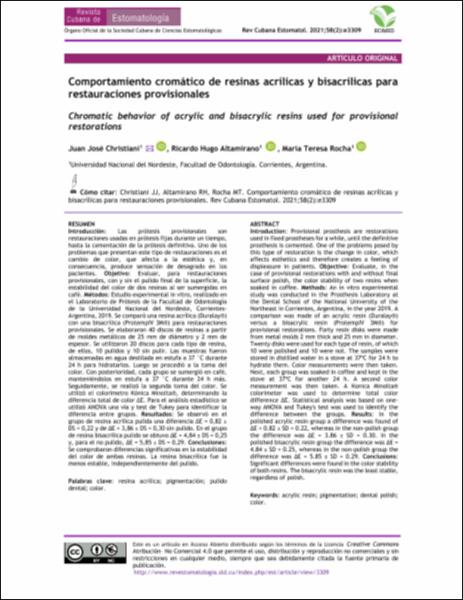Mostrar el registro sencillo del ítem
Comportamiento cromático de resinas acrílicas y bisacrílicas para restauraciones provisionales
Chromatic behavior of acrylic and bisacrylic resins used for provisional restorations
| dc.contributor.author | Christiani, Juan José | |
| dc.contributor.author | Altamirano, Ricardo Hugo | |
| dc.contributor.author | Rocha, María Teresa | |
| dc.date.accessioned | 2022-04-19T18:35:30Z | |
| dc.date.available | 2022-04-19T18:35:30Z | |
| dc.date.issued | 2021-04 | |
| dc.identifier.citation | Christiani, Juan José, Altamirano, Ricardo Hugo y Rocha, María Teresa, 2021. Comportamiento cromático de resinas acrílicas y bisacrílicas para restauraciones provisionales. Revista Cubana de Estomatología. La Habana: Editorial Ciencias Médicas, vol. 58, no. 2, p. 1-11. ISSN-e 1561-297X. | es |
| dc.identifier.issn | 0034-7507 | es |
| dc.identifier.uri | http://repositorio.unne.edu.ar/handle/123456789/33898 | |
| dc.description.abstract | Introducción: Las prótesis provisionales son restauraciones usadas en prótesis fijas durante un tiempo, hasta la cementación de la prótesis definitiva. Uno de los problemas que presentan este tipo de restauraciones es el cambio de color, que afecta a la estética y, en consecuencia, produce sensación de desagrado en los pacientes. Objetivo: Evaluar, para restauraciones provisionales, con y sin el pulido final de la superficie, la estabilidad del color de dos resinas al ser sumergidas en café. Métodos: Estudio experimental in vitro, realizado en el Laboratorio de Prótesis de la Facultad de Odontología de la Universidad Nacional del Nordeste, CorrientesArgentina, 2019. Se comparó una resina acrílica (Duralay®) con una bisacrílica (ProtempIV 3M®) para restauraciones provisionales. Se elaboraron 40 discos de resinas a partir de moldes metálicos de 25 mm de diámetro y 2 mm de espesor. Se utilizaron 20 discos para cada tipo de resina, de ellos, 10 pulidos y 10 sin pulir. Las muestras fueron almacenadas en agua destilada en estufa a 37 °C durante 24 h para hidratarlos. Luego se procedió a la toma del color. Con posterioridad, cada grupo se sumergió en café, manteniéndolos en estufa a 37 °C durante 24 h más. Seguidamente, se realizó la segunda toma del color. Se utilizó el colorímetro Kónica Minolta®, determinando la diferencia total de color ΔE. Para el análisis estadístico se utilizó ANOVA una vía y test de Tukey para identificar la diferencia entre grupos. Resultados: Se observó en el grupo de resina acrílica pulida una diferencia ΔE = 0,82 ± DS = 0,22 y de ΔE = 3,86 ± DS = 0,30 sin pulido. En el grupo de resina bisacrílica pulido se obtuvo ΔE = 4,84 ± DS = 0,25 y, para el no pulido, ΔE = 5,85 ± DS = 0,29. Conclusiones: Se comprobaron diferencias significativas en la estabilidad del color de ambas resinas. La resina bisacrílica fue la menos estable, independientemente del pulido. | es |
| dc.description.abstract | Introduction: Provisional prosthesis are restorations used in fixed prostheses for a while, until the definitive prosthesis is cemented. One of the problems posed by this type of restoration is the change in color, which affects esthetics and therefore creates a feeling of displeasure in patients. Objective: Evaluate, in the case of provisional restorations with and without final surface polish, the color stability of two resins when soaked in coffee. Methods: An in vitro experimental study was conducted in the Prosthesis Laboratory at the Dental School of the National University of the Northeast in Corrientes, Argentina, in the year 2019. A comparison was made of an acrylic resin (Duralay®) versus a bisacrylic resin (ProtempIV 3M®) for provisional restorations. Forty resin disks were made from metal molds 2 mm thick and 25 mm in diameter. Twenty disks were used for each type of resin, of which 10 were polished and 10 were not. The samples were stored in distilled water in a stove at 37ºC for 24 h to hydrate them. Color measurements were then taken. Next, each group was soaked in coffee and kept in the stove at 37ºC for another 24 h. A second color measurement was then taken. A Konica Minolta® colorimeter was used to determine total color difference ΔE. Statistical analysis was based on oneway ANOVA and Tukey's test was used to identify the difference between the groups. Results: In the polished acrylic resin group a difference was found of ΔE = 0.82 ± SD = 0.22, whereas in the non-polish group the difference was ΔE = 3.86 ± SD = 0.30. In the polished bisacrylic resin group the difference was ΔE = 4.84 ± SD = 0.25, whereas in the non-polish group the difference was ΔE = 5.85 ± SD = 0.29. Conclusions: Significant differences were found in the color stability of both resins. The bisacrylic resin was the least stable, regardless of polish. | es |
| dc.format | application/pdf | es |
| dc.language.iso | spa | es |
| dc.publisher | Editorial Ciencias Médicas | es |
| dc.rights | openAccess | es |
| dc.rights.uri | http://creativecommons.org/licenses/by-nc-nd/2.5/ar/ | es |
| dc.source | Revista Cubana de Estomatología, 2021, vol. 58, no. 2, p. 1-11. | es |
| dc.subject | Resina acrílica | es |
| dc.subject | Pigmentación | es |
| dc.subject | Pulido dental | es |
| dc.subject | Color | es |
| dc.subject | Acrylic resin | es |
| dc.subject | Pigmentation | es |
| dc.subject | Dental polish | es |
| dc.subject | Color | es |
| dc.title | Comportamiento cromático de resinas acrílicas y bisacrílicas para restauraciones provisionales | es |
| dc.title | Chromatic behavior of acrylic and bisacrylic resins used for provisional restorations | es |
| dc.type | Artículo | es |
| unne.affiliation | Fil: Christiani, Juan José. Universidad Nacional del Nordeste. Facultad de Odontología; Argentina. | es |
| unne.affiliation | Fil: Altamirano, Ricardo Hugo. Universidad Nacional del Nordeste. Facultad de Odontología; Argentina. | es |
| unne.affiliation | Fil: Rocha, María Teresa. Universidad Nacional del Nordeste. Facultad de Odontología; Argentina. | es |
| unne.journal.pais | Cuba | es |
| unne.journal.ciudad | La Habana | es |
| unne.ISSN-e | 1561-297X | es |
Ficheros en el ítem
Este ítem aparece en la(s) siguiente(s) colección(ones)
-
Artículos de revista [303]





